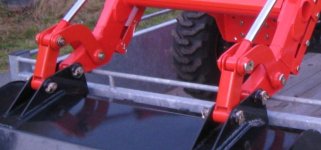DK35vince,
I agree with you but I think there is some confusion as to when and where the stops are contacting the Q A assembly, etc. Let me clarify. When I push the bucket pistons out their normal full travel the stop that engages is the one where the Q A assy. hits the underside of the fel arms. These two stops restrict any further rollback of the bucket edge toward the underside of the tractor's nose.
What I don't yet know is: when the contact above is made and the tractor is used to backdrag the bucket edge while moving in reverse is it the weakness of the Q A stop hitting the underside of the fel's stop that causes the Q A stop to bend
OR is it the cylinder trying to resist the forward force against the bucket blade, when something like a rock or other immovable object is encountered, that causes the bucket to go forward and then be forced back against the stop by the pistons pressure, with such force as to do damage to the Q A stops, as a result of the pistons being able to now overextend because of the bent Q A stop and so on until everything is bent beyond recognition?
Phew, hope that makes sense...it is a lot to detail, but I'm leaning toward the pistons being able to push harder than and further than they ought to if the entire fel worked as one would expect it to. For definition sake lets say the loader ought to be able to handle what the bucket can handle, and so far there is NO visible sign of distress to the bucket. I would therefore posit that the fel is the weak link as is exemplified by the damage incurred and the fact that it and not the bucket is taking the brunt of the stress. Furthermore the fel is under designed to handle the bucket it is intended to be able to support. From the opposite view if the pistons were designed to only travel so far as for the bucket to just touch the Q A stops on the underside of the fel then it would be impossible for the damage that has been sustained to date to have occurred in the first place. In fact, as the Q A stops became damaged the pistons would have likely restricted the further movement of the bucket, Q A stops bending further and any possibility of the pistons extending to the point that they would touch the fel arms. The other likelihood is the pistons would pull out of the cylinders or damage them severely, instead of what is happening currently.
So if I'm right, ( and I'm not saying I am, just supposing

) then the solution would be to allow only so much extension of the pistons- LESS than the current design allows for. And to make the Q A stops more solid and less able to bend, thus eliminating the current mess known as my tractor.



